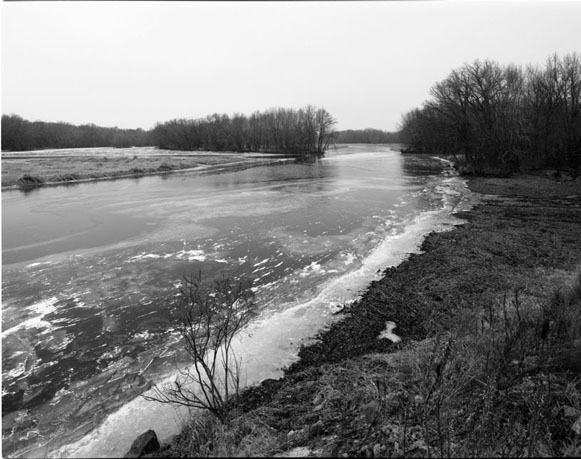
Large Format Lenses
Light fall-off in wide lenses

Frozen Mississippi near Lansing, IA. Demonstrates the use of the 72mm Super-Angulon XL lens with and without center filter. I used almost no movements with this image (<2 deg of front tilt & a bit of front fall).
Light fall-off is the characteristic of a lens that describes the gradual darkening, from center to edge, of the image projected on film. The idea is that fall-off is inversely proportional to focal length, so that the shorter focal lengths suffer the most. See https://en.wikipedia.org/wiki/Vignetting for a discussion of this.
The slideshow above shows two photos of the same scene superimposed (JavaScript required), one without & one with the center filter installed. I used the 72mm Super Angulon XL lens and the Schneider IVb center filter that is recommended by Schneider for this lens.
As you can see there is some light fall-off with this lens and some loss of detail around the edges. You may need the center filter with this lens, though some have said they haven't missed it. If you don't get the CF, then you might want to give a little extra exposure (with perhaps a slightly shorter development time) to keep any shadow detail around the edges from being underexposed. I mostly use the center filter with architectural subjects, but am less concerned when shooting landscapes. The film used above was TMax 100 4x5 sheet film. The scans are plain vanilla, no funny business used.
Of course, there can be an artistic reason to want the light fall-off, but it's best to make that decision an informed one.
The math for natural vignetting is:
(cos(atan(d/2f)))4
where d = length of the film diagonal and f = the focal length of the lens.
The formula yields the proportion of light falling on the outer edge as compared with the center of the image. It applies only to a centered lens using no movements. If you want to include movements, just add twice the movement distance (as seen by the film) to d above—it's equivalent to increasing your film size.
So, with my Schneider 72mm Super-Angulon XL lens and 4x5 film (163mm diagonal) and no movements we get:
fall-off = (cos(atan(163mm/2 * 72mm)))4 or about 20% of light at the center hits the edge, which is about 2 stops down at the corners.
One way to deal with fall-off, if it isn't too extreme, is just to compensate when making prints and, usually, with a bit more exposure so no details are lost at the edges. But, using a center filter (CF) is the way many photographers deal with this, using the exposure guidelines included with the center filter. I expect the CF is a requirement if you shoot color transparencies, especially high-contrast types like Velvia & E100VS.
A center filter is basically a neutral density filter that's graduated in a circular pattern so it's denser in the center than at the edges. It's best to follow the lens manufacturers recommendation for center filter selection. They are quite expensive, presumably due to the difficulty in manufacture.
Stopping the lens down does not help with natural fall-off.
LF Lens Resources
Test and performance data for many current and vintage LF lenses can be found at http ://www.hevanet.com/cperez/testing.html.
Data sheets for major manufacturers' lenses:
- Nikon
- Rodenstock
- Schneider: Recent and Vintage
- Fuji
Kerry Thalmann keeps a great list of Future Classics, and other interesting lens resources. He has also written a series of articles for View Camera Magazine.
The most difficult thing about choosing lenses is sorting through all the alternatives. The Large Format Photography Forum contains many discussions on lens selection and is an excellent resource. Also The Large Format Home Page has a great set of articles on the subject, including lens comparison data. My own approach to lens selection is to try for about a 10°-15° angle of view separation between the lenses I own, so my 'stable' includes 55mm, 72mm, 90mm, 110mm, 150mm, 210mm, 300mm lenses. This seems to give me a small enough granularity of angle of view.
Site contents are
All trademarks and logos belong
to their respective owners.
Page last modified:
30-Apr-2021
